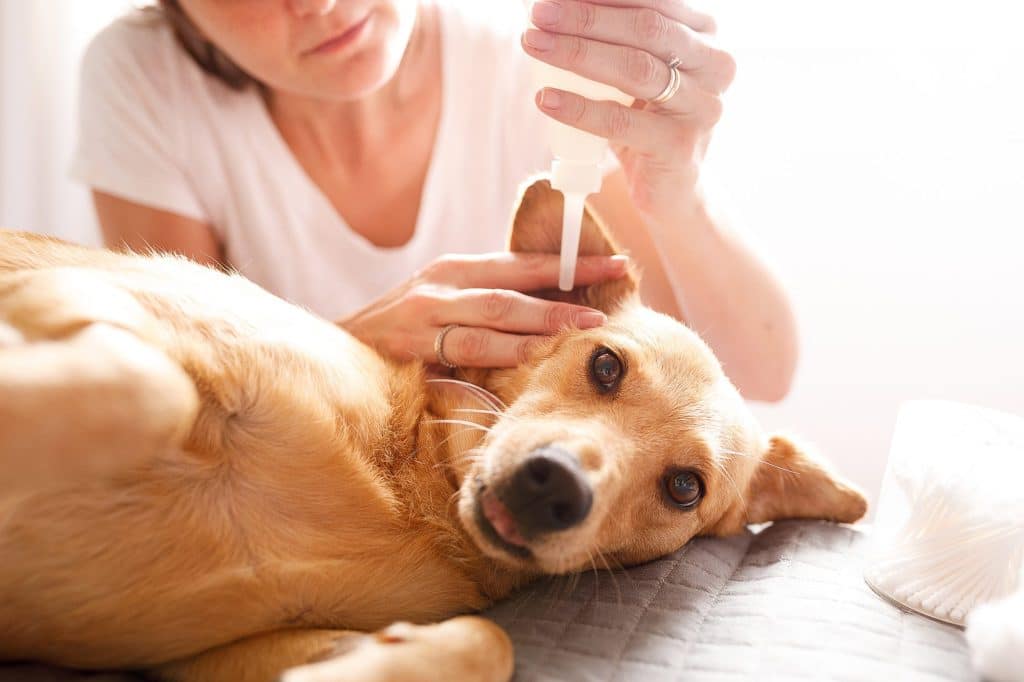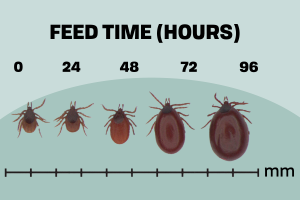Ear infections are quite common in dogs and other pets as they play around in the dirt. And don’t maintain a sense of hygiene as we do. Despite being common, they’re certainly a cause for concern.
Watch out for discomfort; digging in might lead to a concerning discovery. Common infections that can affect dogs include skin infections, bacterial and viral infections, ear infections, and urinary tract infections.
Ear infections can range from minor to serious and can cause a great deal of discomfort and distress to your pet. Bacteria and yeast usually cause them, and in rarer cases, parasites like mites.
It’s important to be aware of the signs and symptoms of an infection so that you can take appropriate action.
How to identify ear infections in dogs?
1. Always stay on the lookout for symptoms.
The first step to identifying a potential infection is to pay attention to changes in your dog’s behaviour. This can include aggression, excessive scratching against rough surfaces, and unsteadiness while standing. These are all signs that something is amiss.
Most importantly, you must pay attention to your dog itching its ears more often than not. While it’s common and usually nothing to worry about, you should still take them to a vet if it happens regularly.
Another sign to look for is unsteadiness or loss of balance. The inner ear houses the vestibular system, which governs your dog’s posture and balance. An ear infection might be the catalyst if your pup repeatedly loses balance while running or standing.
One of the most ignored signs of an underlying infection is aggression. While aggression can be cute at times, most often, it signifies agony. Infections can cause a lot of pain, which worsens in sensitive parts like the ears.
Read More: What is the best worm treatment for dogs? How to do deworming at home?
2. Take your dog to the vet for an examination and diagnosis.
If you suspect an ear infection, you should take your pup to the vet for a full exam. The doctor will likely perform an otoscopy and may take samples of debris inside the ears. Depending on the results, additional tests may be required.
This will help in accurately diagnosing the severity of the infection present and how it should be treated. In addition to the physical exam, you must talk to your vet about any other concerns.
For example, if there are any noticeable changes in your doggo’s behaviour, you must inform your vet of all the changes you notice. It’ll help determine any underlying causes for the behavioural changes you must address.

How to treat dog ear infections?
Generally, ear infections can take a few days to a few weeks to heal completely. If your dog has a mild ear infection, it may be able to heal in a few days with the proper treatment. For chronic ear infections, treatment can take much longer.
1. Follow the vet’s instructions for treatment.
Following your vet’s instructions for treating infections is essential for ensuring a healthy recovery.
Once the cause of the infection has been identified, your vet will likely prescribe ear cleansers to help fight the infection. You must follow the prescription and give all the doses in the case of antibiotics. Don’t cut short your dog’s antibiotic treatment; finish the entire course for the best results.
In addition to antibiotics, your vet might also recommend other treatments such as topical creams, supplements, or even surgery. Be sure to follow all of their instructions to a T.
Antibiotics like itraconazole are used in case of fungal infections, while amoxicillin-clavulanate is used for bacterial infections. Stay close to your pet during their prescribed period; not all dogs react positively to antibiotics.
DO NOT treat your dog with antibiotics without a prescription; mishandling can render the medication useless for future use.
2. Monitor the area for improvement.
Regularly checking the infection site can help track the progress and adjust the treatment’s severity.
Make sure to observe any changes in your dog’s behaviour and the area itself, as this can indicate whether your treatment is effective.
You should also regularly monitor your dog’s body temperature and heart rate, as this can help you determine any underlying or complicating factors that may require further medical intervention.
3. Keep their home clean and dry to reduce the risk of infection.
Keep the area around your dog clean and free of dirt and debris. Hygiene can help prevent infectious organisms from spreading and spreading the infection further.
To prevent the spread of infections, try to keep the dog house clean. This includes regularly cleaning and disinfecting the floor, walls, and furniture.
Additionally, dispose of any waste, such as faeces, in a sealed trash bag and place it in an outside bin. Also, wash your hands with soap and water before and after handling your dog, and avoid contact with other animals.
Regularly washing your dog’s bedding, blankets, and other items will also help to reduce the risk of infection.
Lastly, suppose your dog has a contagious infection. In that case, keeping them away from other animals and people is important until it has been treated. While most ear infections are not contagious, those caused due to parasites like mites certainly are.

4. A nutritious diet and plenty of exercise.
A balanced diet will give your dog the essential vitamins and minerals they need to stay fit. Exercise helps keep your dog’s immune system strong, aiding its infection resistance. Prevention is better than cure!
But that’s far from the only benefit of working out. Regular exercise can help reduce stress levels, making your dog more prone to infections.
Go on regular walks, have them jump around and have fun! A lack of mental stimulation has its own set of issues that follow. Provide them with high-quality, nutritious food to help prevent infection.
Alternatively, you can opt for supplements that help treat inflammation. Omega-3 fatty acids are well-known supplements for treating inflammation and checking the severity of infections.
Are antibiotics necessary to treat ear infections in dogs?
Sometimes, a vet may prescribe oral antibiotics to treat an ear infection in dogs. It’s typically done if the infection is more severe or hasn’t responded to topical treatments. They’re not an absolute solution and must only be taken with a vet’s advice.
Oral antibiotics can help to clear up the infection and reduce the pain and discomfort. However, in many cases, a vet may recommend a topical ointment or ear drops to help clear up the infection.
Read More: Best Flea Treatment For Dogs UK
How to treat a dog’s ear infection with home remedies?
Ear infections are a common problem among dogs; you’ll need a vet visit depending on the severity. Luckily, several home remedies are available for those who want to treat their pup at home.
Here’s a quick guide on using some of the most effective home remedies to treat your dog’s ear infection.
1. White Vinegar
White vinegar is a natural antiseptic with antibacterial and antifungal properties, making it an effective treatment for ear infections in dogs.
To use white vinegar to treat ear infections in dogs, mix one white vinegar with one warm water. Soak a cotton ball or pad in the mixture and gently massage the base of your dog’s ears and then wipe the cotton ball along the inside of the ears to remove any built-up wax and dirt.
Do’s:
- Once the ear is clean, a dropper puts a few drops of vinegar into the ear canal.
- Gently massage the base of the ear for a few seconds to help distribute the solution and allow it to reach deep into the ear canal.
- Let your pup shake his head to help remove any excess solution.
Dont’s:
- Don’t go too deep, as this can cause damage to your dog’s ears.
- Avoid sticking the cotton ball too far into your dog’s ear canal.
Your pup may experience some discomfort when you first start using the vinegar solution. Still, it should start to feel better after a few days.
2. Homemade Earwash
Making your earwash is a natural and cost-effective way to treat your pup’s ear infection, and it’s also relatively easy to do. All you need are a few simple ingredients that you can find in your pantry or at your local pharmacy.
To make an effective homemade earwash, mix equal parts of apple cider vinegar, witch hazel, and water in a bowl. Then, you can either use a dropper to drip the solution into your pup’s ear carefully or dip a cotton ball into the mixture and gently wipe the inside of your pup’s ear.
Do’s
- Once you’ve applied the solution, gently massage the base of your pup’s ear to help the solution reach down into the ear canal.
- Let your pup shake his head to help get rid of any excess solution.
Don’ts
- Do not use the solution inside the ear, as this could cause further irritation.
3. Natural Oils
Tea tree oil is one of the best choices for treating ear infections in dogs. It has anti-inflammatory and anti-bacterial properties that can help reduce inflammation and the infection’s severity.
You’ll need to choose the right natural oil for the treatment. Dilute the oil before use by mixing a few drops with an equal amount of carrier oil, such as almond or olive oil. This will help reduce the oil’s potency, making it safer for your pup.
You can also use coconut oil, which helps soothe the area and reduce inflammation. Olive oil is a great option as well.
Do’s
- Warm the oil before using it. This can be done by placing the oil bottle in warm water for a few minutes.
- Once the oil is warm, use a dropper to put a few drops of either oil into your dog’s ear.
- Gently massage the base of the ear.

How to use Calendula to prevent/treat dog ear infections?
Calendula is a natural remedy that is popular and effective in treating ear infections in dogs. You can use Calendula to prevent and treat dog ear infections. It’s safe to use on your dog’s ears, and the application is easy if you follow the instructions on the box.
Prevention
To use Calendula for preventing ear infections in dogs, mix a few drops of calendula tincture in warm water and use a cotton ball to clean the inside of the dog’s ears.
Allow the mixture to sit in the ear for a few minutes, and then use a clean cotton ball to dry the ear. This should be done once or twice weekly to help prevent ear infections.
Cure
To treat an existing infection, mix a few drops of calendula oil with a carrier oil, such as olive oil, and apply a few drops of the mixture to the inside of the dog’s ears.
Be sure to massage the oil into the ear and allow it to spread evenly for a few minutes before wiping off excess oil with a clean cotton ball.




